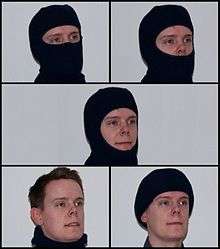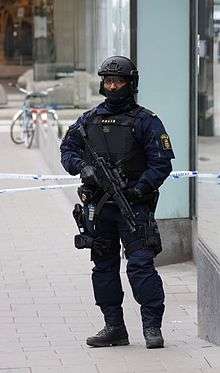Balaclava (clothing)


A balaclava, also known as a balaclava helmet or ski mask, is a form of cloth headgear designed to expose only part of the face. Depending on style and how it is worn, only the eyes, mouth and nose, or just the front of the face are unprotected. Versions with a full face opening may be rolled into a hat to cover the crown of the head or folded down as a collar around the neck.
The name comes from their use at the Battle of Balaclava during the Crimean War, referring to the town near Sevastopol in the Crimea.[1] British troops there wore knitted headgear, to keep warm.[2]
History
Traditional balaclavas were knitted from wool. Modern versions are also made from silk, cotton, polypropylene, neoprene, acrylic, or polar fleece.
This type of headgear was known in the 19th century as an Uhlan cap or a Templar cap.[3]
During the Crimean War in 1854, handmade balaclavas were sent over to the British troops to help protect them from the bitter cold weather. British troops required this aid, as their own supplies (warm clothing, weatherproof quarters, and food) never arrived in time.[4] According to Richard Rutt in his History of Handknitting, the name "balaclava helmet" was not used during the war but appears much later, in 1881.[3]
Uses
Warmth

Modern balaclavas are used in outdoor winter sports such as skiing, snowboarding, and snowmobiling to protect the face from wind and maintain warmth. They are also popular among motorcyclists and bicyclists. It is especially useful for balaclavas to have breathability when used in outdoor sports to prevent fogging of glasses and goggles. Breathable balaclavas are ideal for outdoor sports.
Safety
Firefighters wear a fire-resistant version made of Nomex with a face opening that is covered by their self-contained breathing apparatus (SCBA).
Electrical workers often wear an arc-flash rated version in conjunction with a face shield and other personal protective equipment (PPE) while working on energized equipment.
Race drivers In Fédération Internationale de l'Automobile sanctioned events must wear balaclavas made of fire-retardant material underneath their crash helmets. In racing events, hill-climbs, special stages of rallies and selective sections of cross-country events entered on the International Sporting Calendar, all drivers and co-drivers must wear overalls as well as gloves (optional for co-drivers), long underwear, a balaclava, socks, and shoes homologated to the FIA 8856-2000 standard.[5]
Military and police

British Special Air Service (SAS) troopers wore balaclavas during the storming of the Iranian Embassy in London (Operation Nimrod) in 1980. The balaclavas were worn to conceal the identity of the SAS men because some had been working as undercover "plain clothes" men in Northern Ireland, and might need to resume their duties in the province after the Embassy operation.
In the Indian subcontinent, balaclavas are commonly referred to as monkey caps because of their typical earth tone colours, and the fact that they blot out most human facial features. Monkey caps sometimes have a small, decorative, woollen pom-pom on top. They are commonly worn by troops on Himalayan duty for protection from the cold.[6]
The United States Marine Corps has recently begun issuing balaclavas with hinged face guards as part of the Flame Resistant Organizational Gear program.[7][8]
In the Soviet Union, the balaclava became a part of standard OMON (special police task force) uniform as early as the Perestroyka years of the late 1980s. The original intent was to protect the identity of the officers to avoid intimidation from organized crime. Because of increased problems with organized crime of the 90s, TV shots of armed men in black balaclavas became common. As organized crime decreased, however, balaclavas became as much an instrument of intimidation as identity protection, as they conceal facial expressions of the wearer and make positive identification difficult. Armed Russian police commonly conduct raids and searches of white-collar premises (typically in Moscow) while wearing balaclavas. Such raids have therefore come to be known in Russia as "maski shows", an allusion to a popular comic TV show of the 1990s.[9]
Concealment
A balaclava may be used occupationally by SWAT, special forces personnel, or by criminals to conceal their identities. In Ireland, the balaclava has a long history of use by paramilitary groups dating back to the Irish War of Independence. Notably, the Provisional IRA used balaclavas to conceal their identity.
British Police in Kent confiscated the War on Terror board game partly because of the inclusion of a balaclava. Police said it “could be used to conceal someone’s identity or could be used in the course of a criminal act.”[10]
See also
References
- ↑ Games, Alex (2007). Balderdash & piffle : one sandwich short of a dog's dinner. London: BBC. ISBN 978-1-84607-235-2.
- ↑ Hartston, William. "Top 10 facts about the Crimean War". Daily Express. Express Newspaper. Retrieved March 6, 2018.
- 1 2 Richard Rutt, A History of Handknitting, London 1987, pages 134–5. (Note that there is a misprint in the date of the Battle of Balaclava, which took place 1854, in the original edition cited here)
- ↑ Shepherd, John (1991). The Crimean Doctors: A History of the British Medical Services in the Crimean War. 1. Liverpool University Press. pp. 296–306.
- ↑ "Archived copy" (PDF). Archived from the original (PDF) on 2011-07-11. Retrieved 2009-06-24.
- ↑ Ghosh, Subir (2005) "Thanda lege jabey" Article in 19 Nov Hindusthan Times
- ↑ Archived October 29, 2012, at the Wayback Machine.
- ↑ Archived September 16, 2012, at the Wayback Machine.
- ↑ Kramer, Andrew E. (2011-08-31). "Memo to Exxon: Business With Russia May Involve Guns and Balaclavas". The New York Times.
- ↑ "Latest news from Cambridge & Cambridgeshire. Cambridge sports, Cambridge jobs & Cambridge business – War On Terror board game seized by police". Cambridge-news.co.uk. Archived from the original on 2012-08-06. Retrieved 2009-07-15.
External links
